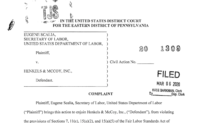Highway Infrastructure
EPA Threatens Cut in California's Federal Highway Funds
National construction groups weigh in on the issue
In a new salvo against the state of California, the U.S. Environmental Protection Agency has threatened to restrict uses for some federal highway aid to the state unless it moves to withdraw what EPA terms “backlogged and unapprovable" plans that outline steps the state would take to reduce pollution and meet Clean Air Act standards.
EPA Administrator Andrew Wheeler, in a Sept. 24 letter, told California Air Resources Board Chairman Mary Nichols the state must withdraw inactive State Implementation Plans, or SIPs. The plans contain regulations and other documents that a state intends to use to cut pollution in jurisdictions where it fails to adhere to federal standards for ozone, carbon monoxide and several other pollutants.
“California has the worst air quality in the United States,” Wheeler said, adding that the state has 82 areas, with a total population of 34 million, that do not meet the standards. That is more than twice the number of people in any other state who live in such “nonattainment” areas, he said.
Wheeler said there are more than 130 California SIPs “backlogged” at EPA, about one-third of the agency’s total backlog of such plans. He added, “Most of these SIPs are inactive and appear to have fundamental issues related to approvability, state-requested holds, missing information or resources.”
If California doesn’t withdraw the “backlogged and unapprovable SIPs,” Wheeler warned, EPA will start the process to disapprove them. One consequence of a disapproval is that it starts the “clock” for implementing a cutback in federal highway funding in some parts of the state.
Wheeler asked Nichols for a response by Oct. 10.
California officials react
Richard Corey, executive officer of the California Air Resources Board (CARB), said in a statement that Wheeler’s letter “contains multiple inaccuracies, omissions and misstatements.” Corey added, “EPA has unclean hands; it sat on these documents for years and is now pounding the table about paperwork issues of its own creation.”
He said, “We will continue to do work with EPA on its backlog, but EPA needs to do its job and protect air quality.” For example, Corey called on EPA to take steps to curb air emissions from heavy trucks, locomotives, aircraft and ships.
He also noted that Wheeler’s letter came just days after EPA notified California that it was revoking its waiver to set more stringent automobile fuel-efficiency standards than EPA’s for the rest of the U.S.
EPA's letter didn't state how much funding for California is at issue. Federal Highway Administration data show that the state's total fiscal 2019 federal-aid highway funds are slightly less than $4 billion.
But in an email response to ENR's questions, the CARB said the number is much higher—"Tens of billions of dollars are at stake," it said.
Even if EPA disapproves one or more California SIP, or finds the plans are incomplete, funds wouldn't be cancelled. But their uses would be limited to certain project types, such as highway safety improvements. They also could be shifted to transit projects, according to Jeff Davis, a senior fellow at the Eno Center for Transportation.
A sanction also wouldn't happen quickly. The CARB says that the Clean Air Act requires EPA to impose funding sanctions starting no earlier than 18 months after a disapproval, if the problem isn't fixed before that deadline.
The California board underscored that sanctions would only kick in if a SIP deficiency isn't corrected and added that it has a strong record of correcting any such deficiencies.
National construction groups weigh in
National construction and transportation groups are weighing in on the EPA-California issue. They observe that highway projects can help reduce air pollution by easing congestion and speeding traffic along.
The Associated General Contractors of America is asking EPA to give California a “grace period” to let it finalize its implementation plans.
In a Sept. 24 letter to Wheeler, Jimmy Christianson, AGC vice president for government relations, also said that a cut in highway funding “would only penalize the very communities the Clean Air Act was intended to protect: failing to deliver on vital infrastructure and improvements to air quality.”
Christianson added, “Using federal highway funding as a cudgel is counterproductive to the administration’s promise to deliver on infrastructure and the environment.”
Nick Goldstein, American Road & Transportation Builders Association vice president for regulatory and legal issues, said in an interview, “Federal highway funding is an integral part of achieving air quality goals and putting it at risk is at odds with the goals of the Clean Air Act.”
Goldstein also says that another, related provision of the clean air statute—which deals with ensuring that transportation projects conform to the goal of meeting air quality standards—needs to be changed.
ARTBA Chief Executive Officer David Bauer said in a Sept. 26 letter to Wheeler, "Transportation conformity has become a top-heavy bureaucratic exercise that puts more emphasis on administrative details than on real-world outcomes."
Bauer added, "The fact that needed highway funds hang in the balance of this dubious process should be a concern for all states."
Until the conformity process is rewritten, Bauer said, EPA should "separate—by regulation or practice—needed federal highway infrastructure improvement efforts from state work to comply with federal air quality standards."
Story updated on 10/2/19 to clarify what an EPA sanction would entail and also to include information from Eno Center for Transportation.




